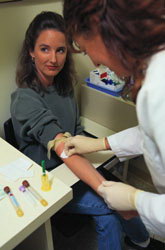Novel drug-targets for hyperlipidaemia treatment
Hyperlipidaemia involves abnormally high levels of lipids or lipoproteins in the blood. Hyperlipidaemia is usually due to genetic or other underlying causes, such as diabetes. Lipid and lipoprotein abnormalities are common in the general population, and are regarded as a risk factor for cardiovascular disease due to their influence on atherosclerosis. European scientists joined their strengths in the EU-funded project Steroltalk, for the development of a common strategy for the discovery of new drug targets to treat hyperlipidaemias. For that purpose, functional genomics tools, model organisms and in silico modelling were employed for the discovery of potential targets and novel drugs. Moreover, possible drug-drug interactions were detected and evaluated. Steroltalk scientists developed novel tools and approaches for the functional genomics studies of hypolipidaemic drugs. These resources included human and mouse microarrays, a variety of novel antibodies against key enzymes of cholesterol synthesis, and recombinant yeast strains that over express human enzymes. An in silico model for the prediction of the action of novel hypolipidaemic drugs was established by Steroltalk. This dynamic model verified the action of both known and novel potential drugs. The results gave valuable insights into the multi-level response of cholesterol homeostasis to known (statins) and evaluated drugs. Moreover, the bio-informatically–supported construction of regulatory networks identified a new transcriptional regulator of cholesterol synthesis. The function of this protein was experimentally proven and it is a potential target in a future therapeutic approach. Cutting-edge proteomics approaches were employed and optimised for the identification of new key players involved in relevant regulatory networks. Such networks include cholesterol synthesis and other metabolic pathways. A database was established by Steroltalk to enable protocols, samples and data dissemination within the consortium. Importantly, the tools and resources developed by Steroltalk will be active, upgraded and maintained by the coordinating University of Ljubljana in Slovenia. The database will initially be freely available to all partners of Steroltalk and then, after the first year, the cost will be shared among the users. Steroltalk developed a plethora of tools, methods, procedures and reagents, which are available to the scientific community and will facilitate further research in the field. This significant amount of information and resources will contribute to the research on cholesterol synthesis and drug metabolism networks towards hyperlipidaemia prevention and treatment.







